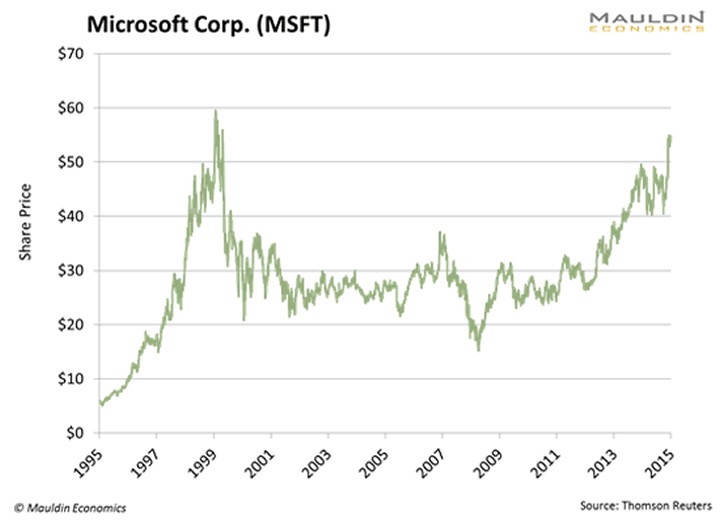How Stocks Bull Markets End
Stock-Markets / Stock Markets 2015 Dec 04, 2015 - 11:14 AM GMTBy: John_Mauldin
 By Jared Dillian
By Jared Dillian
Many people think that they ring a bell at the top of a bull market. Ding-a-ling-a-ling.
That is indeed often the case. The bell was rung in 2000 at the top of the dot-com bubble—I like to think it was 3Com spinning off Palm that broke its back.
But sometimes there is no bell, no catalyst, no story to tell. A bull market becomes a bear market, and it happens just like that.
Silicon Valley has been in a food fight for about three years now. Everyone knows it’s going to end, except for the folks in Silicon Valley. These guys are funny. I met a few of them in the last cycle. They really thought it was going to go on forever.
There are now 145 unicorn companies (private companies with a valuation of $1 billion or more), with a total combined valuation of $506 billion.
We are watching the top happen right before our eyes.
Square
If you were paying attention a couple of weeks ago, you might have read the news about a company called Square going public. Jack Dorsey is the CEO of Square. He is also the CEO of Twitter. I think of this sometimes whenever I complain that I’m too busy.
Square got a round of financing in 2014 at a $6 billion valuation, and now it’s a public company. If you pull up SQ on Yahoo! Finance, you will see that the market cap is $4 billion.
As Square was making the rounds in the roadshow, investors decided they didn’t want to overpay just to make the mezzanine round investors rich. So there wasn’t much demand for Square at a $6 billion market cap. It eventually went public at a $3 billion market cap, or $9/share. (The deal performed well in the aftermarket, at least. The stock is trading at $12.)
No catalyst. No bell ringing. The price simply got too high, and people pulled back. But you know what this means. If one deal can trade below private valuations, they can all trade below private valuations.
On to the next data point…
Fidelity
You may not know this, but Fidelity owns shares of private companies in some of its funds (like Contrafund). Fidelity has to figure out how to value these things.
In general, venture capital firms have to mark their investments to “market,” whatever that means. To do this, they use the services of third party valuation firms. Those valuation guesses are probably subject to mood or opinion, and as you can imagine, there are a lot of bad guesses. The valuations don’t mean much—if you’re an LP (limited partner), at the end of the day, you care about cash in and cash out. But mark-to-market creates some interesting short-term incentives.
As for Fidelity, they also have to mark things to market, and they also use valuation firms. But valuation firm A that Sequoia is using is different than valuation firm B that Fidelity is using. And Fidelity perhaps wants its valuation firm to be more conservative.
So Fidelity has been marking its private investments to market at levels that are below the most recent funding rounds. This puts the VCs in a bit of a pickle. Do they copy Fidelity or do they press on with their own, higher valuations in the face of dissenting opinions?
None of this makes people very bullish on startups.
Uber
Uber is the biggest unicorn of all, with a $50 billion valuation. Side note: they don’t make any money.
Uber is trying to raise another billion—at a $70 billion valuation.
Now, the only reason you would invest in Uber at a $70 billion valuation is if you thought they would go public at $80 billion or more. But looking at what happened to Square, that will almost definitely not happen.
And why would you pay $70 billion for Uber when Fidelity is going to mark it in your mush? Another great question.
I don’t think anyone is in the mood to pay $70 billion for Uber. Uber is stuck. They will have to go public or take a down round if they really need the cash.
And this, folks, is how bear markets start.
Brainstorming Session
So let’s do some brainstorming on what this could mean if it really were the end of the line for Silicon Valley (at least in the medium term).
- Since tech has been going up while energy/mining has been going down, could this trend reverse?
- Could value start to outperform growth? (If I’m not mistaken, it already is.)
- Could large cap start to outperform small cap? (Boy, is it ever.)
- If you lived in the Bay Area, would you want to sell your house and rent?
- As new tech is in the process of topping, have you seen what old tech has been doing? Check out the chart of Microsoft, at 15-year highs:

For full disclosure, I started calling the top (or at least asking hard questions) on Silicon Valley about a year and a half ago. But I think most dedicated observers saw what happened with the Square IPO and said, “Yep, that might be the top.”
The other thing I’ve learned is that even when people recognize the top, they vastly underestimate how bad the pain is going to be on the downside. “Oh, it’ll just be a quick correction.” Never is.
One last riposte: Anyone who invested at these valuations will richly deserve what’s coming to them. Those prices were cuckoo.
Jared Dillian
If you enjoyed Jared's article, you can sign up for The 10th Man, a free weekly letter, at mauldineconomics.com. Follow Jared on Twitter ;@dailydirtnap
John Mauldin Archive |
© 2005-2022 http://www.MarketOracle.co.uk - The Market Oracle is a FREE Daily Financial Markets Analysis & Forecasting online publication.



